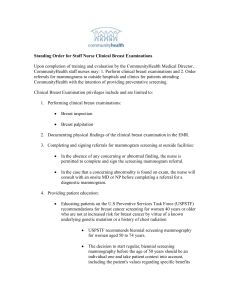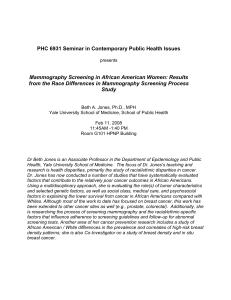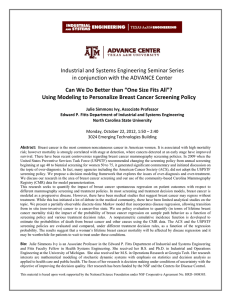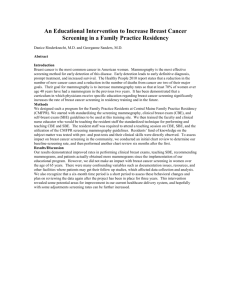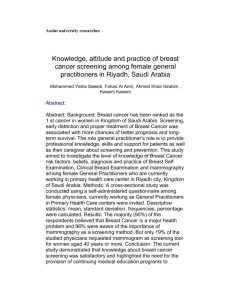Breast Cancer Screening: A Case Study in Using Models to... I. Introduction
advertisement
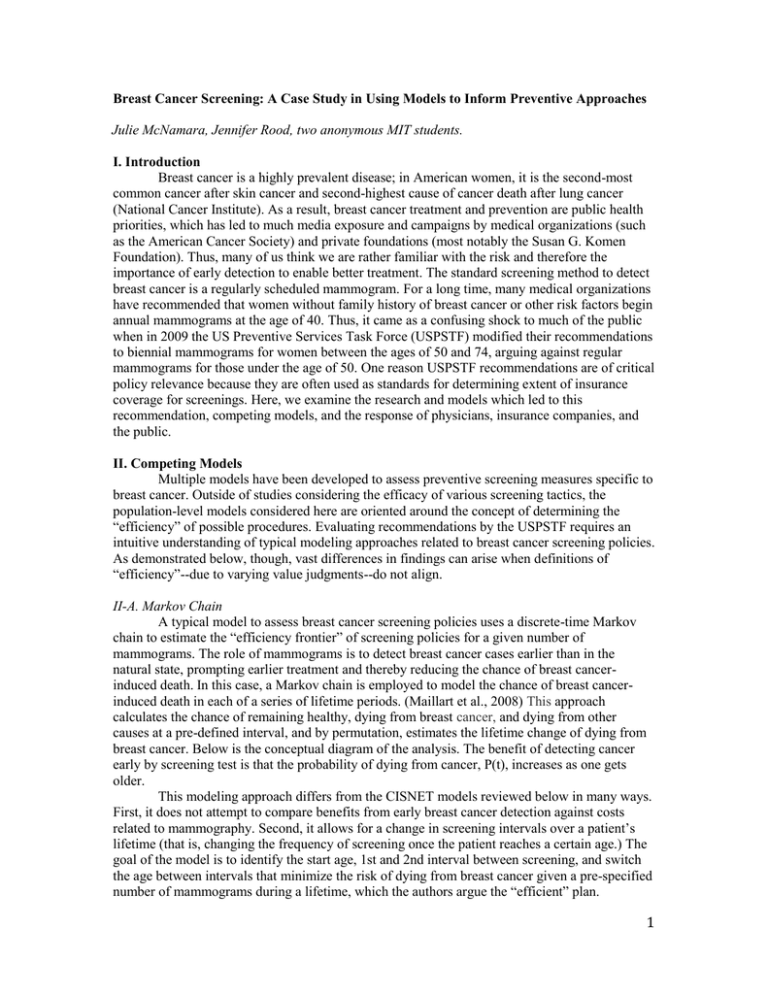
Breast Cancer Screening: A Case Study in Using Models to Inform Preventive Approaches Julie McNamara, Jennifer Rood, two anonymous MIT students. I. Introduction Breast cancer is a highly prevalent disease; in American women, it is the second-most common cancer after skin cancer and second-highest cause of cancer death after lung cancer (National Cancer Institute). As a result, breast cancer treatment and prevention are public health priorities, which has led to much media exposure and campaigns by medical organizations (such as the American Cancer Society) and private foundations (most notably the Susan G. Komen Foundation). Thus, many of us think we are rather familiar with the risk and therefore the importance of early detection to enable better treatment. The standard screening method to detect breast cancer is a regularly scheduled mammogram. For a long time, many medical organizations have recommended that women without family history of breast cancer or other risk factors begin annual mammograms at the age of 40. Thus, it came as a confusing shock to much of the public when in 2009 the US Preventive Services Task Force (USPSTF) modified their recommendations to biennial mammograms for women between the ages of 50 and 74, arguing against regular mammograms for those under the age of 50. One reason USPSTF recommendations are of critical policy relevance because they are often used as standards for determining extent of insurance coverage for screenings. Here, we examine the research and models which led to this recommendation, competing models, and the response of physicians, insurance companies, and the public. II. Competing Models Multiple models have been developed to assess preventive screening measures specific to breast cancer. Outside of studies considering the efficacy of various screening tactics, the population-level models considered here are oriented around the concept of determining the “efficiency” of possible procedures. Evaluating recommendations by the USPSTF requires an intuitive understanding of typical modeling approaches related to breast cancer screening policies. As demonstrated below, though, vast differences in findings can arise when definitions of “efficiency”--due to varying value judgments--do not align. II-A. Markov Chain A typical model to assess breast cancer screening policies uses a discrete-time Markov chain to estimate the “efficiency frontier” of screening policies for a given number of mammograms. The role of mammograms is to detect breast cancer cases earlier than in the natural state, prompting earlier treatment and thereby reducing the chance of breast cancerinduced death. In this case, a Markov chain is employed to model the chance of breast cancerinduced death in each of a series of lifetime periods. (Maillart et al., 2008) This approach calculates the chance of remaining healthy, dying from breast cancer, and dying from other causes at a pre-defined interval, and by permutation, estimates the lifetime change of dying from breast cancer. Below is the conceptual diagram of the analysis. The benefit of detecting cancer early by screening test is that the probability of dying from cancer, P(t), increases as one gets older. This modeling approach differs from the CISNET models reviewed below in many ways. First, it does not attempt to compare benefits from early breast cancer detection against costs related to mammography. Second, it allows for a change in screening intervals over a patient’s lifetime (that is, changing the frequency of screening once the patient reaches a certain age.) The goal of the model is to identify the start age, 1st and 2nd interval between screening, and switch the age between intervals that minimize the risk of dying from breast cancer given a pre-specified number of mammograms during a lifetime, which the authors argue the “efficient” plan. 1 While the Markov chain approach makes sense given the heterogeneity of economic conditions and risk aversion across individuals, its prescriptive power for formulating public policies might be reduced as the “optimal” number of lifetime screening tests cannot be derived in this framework. Additionally, this model implies that the alternative screening policies evaluated by the USPSTF are not an exhaustive set of screening policies. Relaxing one assumption—that a patient may change her screening interval once throughout her lifetime— improves efficiency significantly. Similar to limitations seen with other models, this highlights the fact that recommendations based on models are sensitive to initial assumptions. Figure 1. Conceptual diagram of the Markov chain model. II-B. CISNET The work done by the Breast Cancer Working Group of the Cancer Intervention and Surveillance Modeling Network (CISNET) was instrumental in guiding the USPSTF Recommendation Statement. The CISNET group developed 6 independent models of breast cancer incidence and mortality using the same clinical data and 20 mammography screening strategies. The strategies varied by age of initiation and cessation, and by screening interval, among a cohort of U.S. women born in 1960 and followed from age 25 onward (Mandelblatt et al., 2009). The models assessed: 1) the benefits of screening in reducing breast cancer mortality and gaining life-years because of averted or delayed breast cancer death, and 2) the harms of screening due to false-positive mammograms, unnecessary biopsies, and overdiagnosis. The models then ranked the 20 strategies by efficiency, measured as the model output with the most gains in health outcome (life-years gained or deaths averted) while consuming the fewest resources or costs. Finally, the models underwent sensitivity analysis in which the input variables were varied to test if the strategy rankings changed (i.e., an examination of robustness). The CISNET group noted several limitations in the models it developed, including: 1) no reflection of personal data for individual women, 2) an assumption of 100% adherence to all screenings and treatments, 3) not capturing differences among certain risk subgroups (such as genetic mutations or race), 4) not capturing morbidity associated with surgery for screeningdetected disease, and 5) not capturing quality of life decrements associated with screening harms onward (Mandelblatt et al., 2009). The CISNET group concluded that biennial intervals were more efficient and provided a better balance of benefits and harms. Further, they noted that although initiating screening at age 40 versus age 50 slightly reduces mortality, it does come at the cost of increasing the number of false-positives reported onward (Mandelblatt et al., 2009). 2 III. USPSTF Interpretations and Actions The USPSTF is an independent, 16-person panel comprised of non-federal primary care providers that are experts in areas of prevention and evidence-based medicine. Each of the 16 are appointed following a public nomination process, and volunteer for 4 to 6-year terms. The group is responsible for making recommendations regarding the appropriateness of various preventive care services for asymptomatic patients (USPSTF 2013). To make recommendations, the task force measures the benefits of a service against its potential harms, as determined through assessments of existing peer-reviewed evidence. Here, "benefits" are considered more broadly than simply disease identification; per its documented Methods and Processes, the group "focuses on maintenance of health and quality of life as the major benefits of clinical preventive services" (USPSTF 2013). In addition to breast cancer screening, the USPSTF issues recommendations for other screenings like depression, Alzheimer's, and family violence (USPSTF 2013). All recommendations are specific to the primary care setting, and each recommendation is accompanied by a letter grade indicating its relative strength and degree of certainty (see Table 1). Grade Definition A The USPSTF recommends the service. There is high certainty that the net benefit is substantial. B The USPSTF recommends the service. There is high certainty that the net benefit is moderate or there is moderate certainty that the net benefit is moderate to substantial. C The USPSTF recommends selectively offering or providing this service to individual patients based on professional judgment and patient preferences. There is at least moderate certainty that the net benefit is small. D The USPSTF recommends against the service. There is moderate or high certainty that the service has no net benefit or that the harms outweigh the benefits. I Statement The USPSTF concludes that the current evidence is insufficient to assess the balance of benefits and harms of the service. Evidence is lacking, of poor quality, or conflicting, and the balance of benefits and harms cannot be determined. Table 1. Recommendation Letter Grades. The USPSTF assigns letter grades to its recommendations as a way of indicating the relative strengths of each specific statement. Grades range from A-D in terms of strength, or can be labeled “I” for insufficient evidence. In 2009, the USPSTF updated its 2002 recommendations regarding screening protocols for breast cancer in the general population based on a new systematic review (containing a new randomized controlled trial) as well as the CISNET modeling studies discussed above. In its assessment, it measured benefits of detection and early intervention as reductions in breast cancer mortality, and harms as psychological duress, unnecessary imaging tests and biopsies for women without cancer, and inconvenience due to false-positive screening results. The group did not consider financial costs. In its recommendation report, the group noted that false-positives were more common for women aged 40-49, while in the older age groups overdiagnosis was of greater concern (USPSTF 2009). Therefore, because the harms of screening remained across age groups while the benefits associated with initiating screening at age 40 as opposed to age 50 were small, the task force recommended biennial screening for ages 50 through 74, and earlier screening was to be discussed at the individual level with personal physicians (i.e., a Grade C recommendation for 4049, a Grade B recommendation for 50-74). The USPSTF determined that there was insufficient 3 evidence to support a recommendation one way or the other for those aged 75 and older (i.e., a Grade I recommendation). Importantly, when considering the CISNET studies, the USPSTF elected to maximize mortality as opposed to life-years gained. In December 2009, the USPSTF issued an update to its November 2009 recommendation to “clarify its original and continued intent” regarding screening for women aged 40-49. Specifically, the group struck from the record the original first sentence, which explicitly recommended against biennial screening in 40-49 year-olds, and edited the content to read: “The decision to start regular, biennial screening mammography before the age of 50 years should be an individual one and take patient context into account, including the patient’s values regarding specific benefits and harms” (USPSTF 2009). IV. Responses to the USPSTF 2009 Recommendation Statement When the USPSTF issued its revised Recommendation Statement in November 2009, it met with an immediate and nearly universal backlash. Ultimately, the group had issued a population-level recommendation that was immediately and uniformly interpreted from the individual-level perspective. Here, we briefly consider the resulting responses and actions of physicians, patients, and insurers. IV-A. Physicians Physicians and other healthcare professionals largely denounced the USPSTF 2009 Recommendation Statement. The American Congress of Obstetricians and Gynecologists (ACOG), American Cancer Society (ACS), the National Cancer Institute (NCI), and the National Comprehensive Cancer Network (NCCN) all continued to stand by their recommendation of annual mammography screenings starting at age 40. The ACS, for example, stated that the USPSTF was “essentially telling women that mammography at age 40 to 49 saves lives; just not enough of them” (ACS). However, a few associations, such as the American College of Physicians, endorsed USPSTF’s recommendation (Moore, 2010). In light of the task force recommendations, healthcare professionals have to reconsider their recommendations to their patients. If they stick with the status quo, they are erring on the side of caution, although they are also gaining more financially because they will charge for both screenings and any follow-up procedure more frequently. IV-B. Public/Patients The Task Force recommendations were particularly confusing for many women because they seemed to contradict previously provided information. Many studies indicate that the public perception of breast cancer risk and mammography benefits has been heavily influenced by media treatment of the issue. A 2009 study of public perception of breast cancer risk noted that in a survey of 6 widely-read American newspapers, mammography articles were twice as likely to emphasize its benefits; in a separate survey of the 10 largest US newspapers and the 3 major television networks found that 60% of stories on the topic only discussed the benefits of mammography and recommended that women should “probably” or “definitely” have mammograms, without discussing any attendant drawbacks (Berlin, 2009). As a result, a number of studies have found that public perception of the effectiveness of mammography is optimistic, perhaps even overly so. One study found that women overestimated their chance of dying from breast cancer 20-fold, but at the same time overestimated the value of reducing that risk via mammography by 100-fold; another demonstrated that 44 percent of women believe mammography has a 100-percent chance of detecting cancer (Berlin, 2009). Further, additional survey analyses suggest that the accuracy of risk perception may be influenced by race, education levels, or access to medical care (Haggstrom and Schapira, 2006; HatcherKeller et al., 2013). Given the need to create a solid understanding of screening policies and their rationales, the presentation of conflicting recommendations—as witnessed in the rift between the 4 2002 and 2009 statements—may have a negative effect on the efficacy of and adherence to screening programs. IV-C. Insurance At the time of its 2009 recommendation, the USPSTF was not explicitly in the position to advise insurers or make coverage decisions (Petitti et al. 2010). Its recommendations have, however, long been relied upon as baseline guidance for preventive services in primary care settings. Further, the group’s recommendations were met with great interest by insurance providers, and lent a guiding hand in their determination of extent of coverage. One implication of the 2009 Recommendation Statement, then, was the immediate propagation of concerns that mammograms would no longer be covered by insurers. Although the rumors were contested by the USPSTF, the subsequent arrival of the Affordable Care Act has thrust the role of the USPSTF into the spotlight once more. Ultimately, and outside of many inflammatory descriptors, the group’s recommendations are binding under the Act for Grades A and B at no cost to the patient. Interestingly, the Department of Health and Human Services has elected to defer to the 2002 recommendations, and not the 2009 recommendations, for breast cancer screening (USPSTF 2013). V. Conclusions The use of models, in addition to survey results, to make policy recommendations ideally provides better information for decision makers by painting a more complete or nuanced picture of the problem. However, assumptions about the model parameters and the policy goals of the target audience can heavily influence how the models are interpreted and used. In this case, the CISNET modelers made a set of assumptions about breast cancer screening that differed from the work of other modelers. While it may not be possible to determine if one of these models is objectively “better” than another, it is possible that a given set of assumptions and parameters is better suited to a particular policymaking audience. All of the above-considered models are optimization models, and the modelers are all interested in selecting the most “efficient” process. However, the definition of “efficient” differs depending upon the audience of interest. In fact, the CISNET summary report provides two different sets of optimal screening schemes depending on which aspects of screening are political priorities. By contrast, the USPSTF was effectively forced to issue a clarification as well as a journal editorial in response to misunderstandings surrounding the motivations behind its recommendations. The USPSTF recommendations might not have met with such controversy had they been in line with those proposed by other authoritative organizations. Thus, in 2011, the USPSTF began uploading draft forms of recommendations for online comments prior to finalization, ostensibly to improve legitimacy in the eyes of the public. The outcry following the release of their breast cancer screening statements at the end of 2009 undoubtedly precipitated this shift toward transparency. Additionally, the confusion caused by this controversy might have been resolved by a more thorough explanation of the role of financial and other costs in the Task Force recommendations, something which will be of critical importance during implementation of the Affordable Care Act. 5 Discussion Questions: 1. Previous studies had shown that despite extensive advertising campaigns, patients’ adherence to mammography recommendations is nowhere near 100 percent. Given this information, why do you think the modelers chose to model 100 percent adherence? Should they have added adherence as an extra variable? Why or why not? 2. How can policymakers convey ideas to the public that appear to be detrimental at the individual level yet beneficial at the population level? Is there any way to stave off people abstracting personal interpretations of population-wide concepts? 3. Can you think of a way in which the USPSTF could have deployed its recommendations without creating such a maelstrom? Consider in particular the timing of the information release: recommendations supported screenings for those aged 40-49 one day, then retracted those recommendations the next, and finally settled on leaving it up to the patients and physicians to decide. References American Cancer Society (ACS). 2009. American Cancer Society Responds to Changes to USPSTF Mammography Guidelines. Press Release. Berlin, L. 2009. Malpractice and Breast Cancer: Perceptions Versus Reality. Am J Roentgenology 192 (2), 334-336. http://www.ajronline.org/doi/full/10.2214/AJR.08.1317 Haggstrom, D.A., and Schapira, M.M. 2006. Black-White Differences in Risk Perceptions of Breast Cancer Survival and Screening Mammography Benefit. J Gen Intern Med 21(4), 371377. http://www.ncbi.nlm.nih.gov/pmc/articles/PMC1484725/ Hatcher-Keller, J., Rayens, M.K., Dignan, M., Schoenberg, N., and Allison, P. 2013. Beliefs Regarding Mammography Screening Among Women Visiting the Emergency Department for Nonurgent Care. J Emerg Nursing. doi:10.1016/j.jen.2013.01.015 Maillart, L. M., Ivy, J. S., Ransom, S., & Diehl, K. (2008). Assessing dynamic breast cancer screening policies. Operations Research, 56(6), 1411-1427. Mandelblatt JS, Cronin KA, Bailey S, Berry DA, de Koning H J, Draisma G, Huang H, Lee SJ, Munsell M, Plevritis SK, Ravdin P, Schechter CB, Sigal B, Stoto MA, Stout NK, van Ravesteyn NT, Venier J, Zelen M, Feuer EJ. (2009) Effects of mammography screening under different screening schedules: model estimates of potential benefits and harms. Ann Intern Med 151, 738-47. Moore, H., Budd, GT., Sikon, A., Rim, A., Chellman-Jeffers, M., Crowe, J. 2010. Sorting through the recent controversies in breast cancer screening. doi:10.3949/ccjm.77a.09177 National Cancer Institute. Breast Cancer Screening (PDQ). http://www.ncbi.nlm.nih.gov/pubmedhealth/PMH0032597/ Petitti, D.B., Calonge, N., et al. 2010. Breast Cancer Screening: From Science to Recommendation. Radiology 256, 8-14. United States Preventive Services Task Force (USPSTF). 2013. http://www.uspreventiveservicestaskforce.org/. Last visited 24 April 2013. USPSTF. 2009. Screening for Breast Cancer: U.S. Preventive Services Task Force Recommendation Statement. Ann Intern Med 151, 716-726. 6 MIT OpenCourseWare http://ocw.mit.edu ESD.864 / 12.844J Modeling and Assessment for Policy Spring 2013 For information about citing these materials or our Terms of Use, visit: http://ocw.mit.edu/terms.
